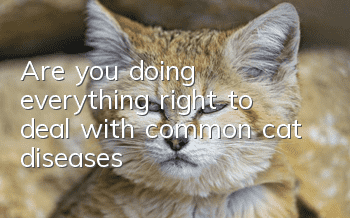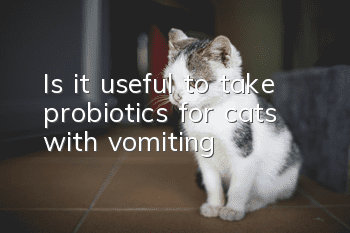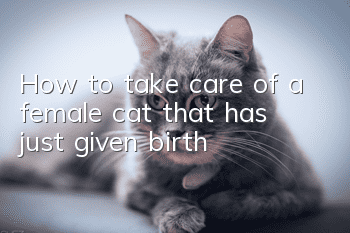Are you doing everything right to deal with common cat diseases?

Things to note when raising cats in spring: Spring is the best breeding season for cats
Although cats can go into estrus all year round, they mostly go into estrus in spring. Cats can go into estrus as early as 6 months old, but at this time the physiological functions of the body are not fully developed yet, so premature mating should be prevented to avoid affecting growth, development and health. Owners of 6-month-old male and female cats at home should pay attention and must supervise them closely at this time!
Female cats in estrus show excitement, restlessness, loss of appetite, and make louder than usual meows at night, commonly known as "cat meowing in spring" to attract male cats. In addition to loss of appetite and wandering at night, the main symptom of male cats in estrus is that they want to find opportunities to go out for activities. In this case, supervision must be strengthened to prevent the cat from escaping. Cats that have been roaming outside should be monitored more closely at this time. Because male cats compete for female cats, they will fight. Cat claws are long and hooked. When the skin is scratched, the wound will be deep and it is easy to become infected and suppurative. When the cat returns from an outing, owners should check it carefully to avoid worsening of the wound due to failure to detect it in time. For owners who want to avoid a series of troubles during the breeding period, they can choose to have male and female cats sterilized.
Note 2 when raising cats in spring: Spring is a time when cats are susceptible to hair ball disease
Spring is here, and it’s the season for cats to moult. This is a period when cats are prone to hair ball syndrome, so parents need to pay more attention. To put it simply, hairball syndrome means that the hair licked into the stomach when the cat licks its fur and cannot be digested by the gastrointestinal tract and cannot be vomited out forms hair balls that block the digestive tract in the cat's gastrointestinal tract, causing the cat to exhibit vomiting and poor appetite. , indigestion, constipation, lack of energy and other symptoms. Some people think that there is no need to worry if the cat will vomit up the hair ball on its own. In fact, this is not the case. When the hair ball blocks the digestive tract, it will become large and hard in the intestine. At this time, the cat can no longer vomit out the hair ball. If If the blockage is severe, it can develop into intestinal obstruction, requiring surgical removal of the hair bulb. Complications such as inflammatory bowel disease are also prone to occur.
The common season for hairy balls:
Generally speaking, since spring and autumn are the seasons when cats shed their fur, cats’ licking habits will be more frequent. At this time, cats will also eat more hair than usual, making them more likely to suffer from hairball disease.
Things to note when raising cats in spring: Cat lovers need to prevent cat-scratch disease in spring
As more and more people keep pets nowadays, some diseases caused by pets such as cats and dogs are also increasing. Medical experts say that cat-scratch disease is generally preventable and treatable, so there is no need to panic. Experts also warn: People who are often exposed to cats and dogs should pay special attention to pet hygiene.. Especially in spring and other animal estrus seasons, special attention should be paid to keeping a distance from stray cats and dogs.
Cat-scratch disease is a zoonotic infectious disease, 80% of which are related to cat scratches and bites. Cat-scratch disease can also be caused by scratches and bites from dogs, rabbits, and monkeys. As the number of owned and stray cats increases, the number of cat-scratch disease cases is also on the rise. There are nearly 10,000 cases of cat-scratch disease worldwide every year. The incubation period of the disease is generally 10 days to 30 days, and in a few cases it can be several months or even 1 to 2 years. Symptoms such as lymphadenopathy and fever may occur during the onset of the disease.
Cat scratch disease can be prevented and cured, so there is no need to panic. If you have a history of being bitten and scratched by a cat, the disease can be diagnosed through laboratory testing. Once the disease is diagnosed and treated symptomatically, the prognosis is generally good. Medical experts warn that people with low immune function may develop serious systemic diseases, such as heart and brain complications, and in rare cases may lead to death. Citing relevant information, he said that about 10% of pet cats and 33% of stray cats carry this disease in their blood, and it is spread among cats through fleas. It is recommended that patients with chronic diseases and those with low immunity should not keep pets. At the same time, you need to avoid being bitten and scratched by animals, especially when animals are in estrus in spring, and stimulate the animals as little as possible to avoid unnecessary harm. In case of being bitten or scratched, you should go to the hospital for rabies vaccination in time.
Things to note when raising cats in spring: Cat colds in spring are not just a trivial matter
Although the temperature is getting warmer in spring, the temperature difference between day and night is large, and cats are more likely to catch cold at night, so more attention must be paid to care to prevent cats from catching colds.
What is a cat cold?
Cold is a common respiratory disease in cats. It is an acute systemic disease mainly caused by inflammation of the upper respiratory tract mucosa. If not treated in time, the inflammation will spread and cause inflammation of the trachea, bronchi, and lungs.
Symptoms of cats having a cold:
1. Depression, crouching and less movement, loss of appetite;
2. Increased body temperature, trembling all over, and coldness at the tips of the ears and nose;
3. Runny nose, frequent coughing, and frequent sneezing;
4. The conjunctiva is flushed and accompanied by secretions;
Factors that cause cats to catch colds:
1. Seasonal changes and sudden changes in temperature reduce the resistance of cats’ respiratory mucosa. (Most common in spring and autumn)
2. Factors such as cats being caught in the rain while out playing, cats being hit by cold air after sweating a lot during exercise, or cats being tired due to traveling or shipping, will weaken the body's resistance and cause colds.
3. Improper maintenance and malnutrition can also cause colds.
4. Colds caused by other respiratory diseases.
- Which is better, a male cat or a female cat? Is it better, a male cat or a female cat?
- How to take care of a cat after giving birth?
- Common internal parasites in cats and their prevention and treatment methods, you must know about them as a cat owner
- Do Siamese cats have good personalities?
- Why do cats get angry?
- How to train Ragdoll cats well? Ragdoll cat training tips!
- What should I do if my cat’s paw pads are dry and rough?
- How to get rid of fleas on American Curl cats?
- The world's largest cat
- Teach you two tricks to make your cat obedient and have an obedient cat!



